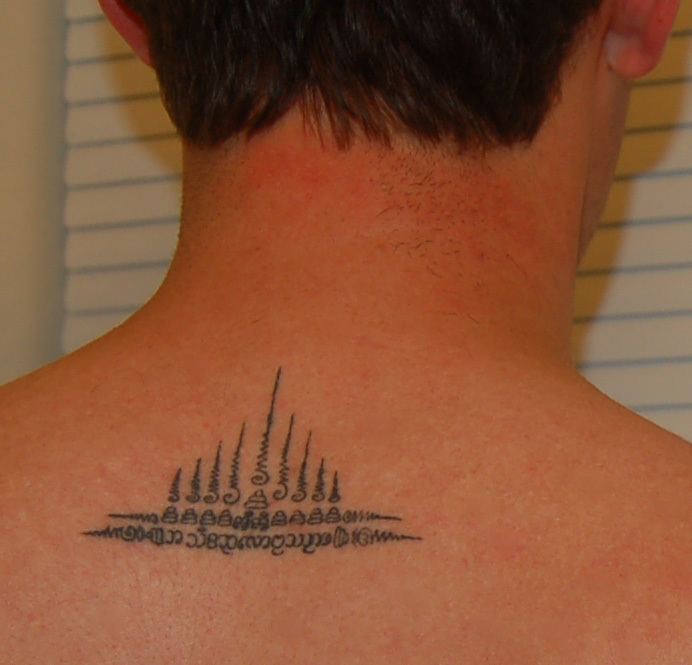 | ||
Yantra tattooing (Thai: สักยันต์; rtgs: sak yan; Khmer: សាក់យ័ន្ត; Burmese: တက်တူးထိုး) is a form of tattooing that originated among the Tai tribes of southwestern China and northwestern Vietnam over 2,000 years ago, according to Chinese chronicles of the time. It consists of sacred geometrical, animal and deity designs accompanied by Pali phrases that offer power, protection, fortune, charisma and other benefits for the bearer. Today it is practiced mainly in Thailand, and to a lesser extent in Cambodia, Laos, and Myanmar.
Contents
Sak means tattoo in Thai, and yan is the Thai pronunciation for the Sanskrit word yantra, a type of mystical diagram used in Dharmic religions.
Sak yan designs are normally tattooed by ruesi (the Thai form of rishi), wicha (magic) practitioners, and Buddhist monks, traditionally with a metal rod sharpened to a point (called a khem sak).
History
Tattoos believed to offer protection and other benefits have been recorded everywhere throughout both mainland Southeast Asia and as far south as Indonesia and the Philippines. Chinese chronicles describe yantra tattooing among the Tai cultures of southwestern China and northwestern Vietnam at least 2,000 years ago. Over the centuries the tradition spread to what is now Cambodia, Laos, Thailand, and parts of Myanmar. While the tradition itself originates with indigenous tribal animism, it became closely tied to the Hindu-Buddhist concept of yantra or mystical geometric patterns used during meditation. Tattoos of yantra designs were believed to hold magic power, and were used much like the kolam tattoos of India. For these people, religion is closely tied to the notion of magic, health, and good fortune.
The script used for yantra designs varies according to culture and geography. In Cambodia and central Thailand, Cambodian Khmer script is used, while in northern Thailand one sees yantra tattoos bearing Shan, northern Thai, or Tai Lu scripts, and in Laos the Lao Tham script is employed. The script spells out abbreviated syllables from Pali incantations. Different masters have added to these designs over the centuries through visions received in their meditations. Some yantra designs have been adapted from pre-Buddhist shamanism and the belief in animal spirits that was found in Southeast Asia and incorporated into Thai tradition and culture.
Meaning
Yantra tattoos are believed to be magic and bestow mystical powers, protection, or good luck. There are three main effects of a yantra tattoo. One is that which benefits the wearer, such as making them more eloquent. Another is that of protection and to ward off evil and hardship. This is commonly used by military personnel, police, taxi drivers, gangsters and others in perceived dangerous professions. Another type is that which affects people around the wearer, such as invoking fear. The tattoo only confers its powers so long as the bearer observes certain rules and taboos, such as abstaining from a certain type of food.
It is believed that the power of sacred tattoos decreases with time. So to re-empower them each year, sak yan masters celebrate with their devotees the Wai Khru ritual. Wai khru means "pay homage to one's guru". In Thailand, the most impressive Wai Khru is held at the temple of Wat Bang Phra.
Sak yan designs are also applied to many other media, such as cloth or metal, and placed in one's house, place of worship, or vehicle as a means of protection from danger or illness, to increase wealth, and to attract lovers. In recent years Hollywood celebrities such as Angelina Jolie, whose tattoos were inked by Ajahn Noo Ganpai in Thailand, have made them popular among women.
However a modern movement in Thailand seeks to progress away from their animistic past. As part of this movement, many modern-day Thais view yantra tattoos as nothing more than good-luck symbols that are stylish.
Types and designs
There are many traditional types and designs of yantra tattoos, but some of the most well-known and popular include:
Locations
Many internet sites recommend Thailand as the place to attain the most refined ritual tattoos and consider the country as the most popular for learning this art. Every year, hundreds of foreigners in search of original and magical tattoos come to Thailand to have their tattoos done. In Southeast Asia, Thailand is by far the country with the highest number of devotees.
Backlash
While tattoos in the west are largely a matter of aesthetics, in Thailand they are imbued with both spirituality and superstition. The designs, lines of script, geometric patterns and animal shapes, are deeply interwoven with Buddhist and animist imagery that some Thais fear Westerners fail to appreciate. Tattoos of religious deities are problematic, especially if they are below the waist. In Southeast Asian culture, the head is the most sacred part of the body. The further down the body, the less sacred, and foreigners with religious figures inked on their legs have caused upset. On the main highway into Bangkok from the city's Suvarnabhumi Airport, 15-metre-wide billboards declare "It's wrong to use Buddha as a decoration or tattoo". Some groups want a complete ban on any tattoos of religious figures.
